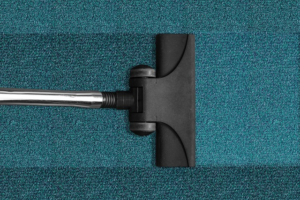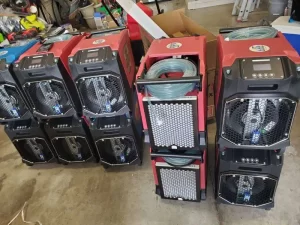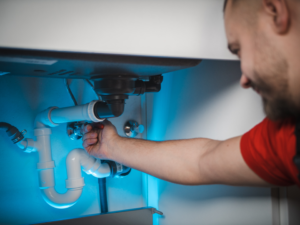Fridges with water dispensers are one of life’s greatest conveniences: there’s nothing better than enjoying a cold sip of water with a nice glass of ice. However, fridges that have this convenient feature also have the potential to leak, causing major damage to your floor.
What is a refrigerator water line?
If your refrigerator has a water dispenser or ice maker, then it’s got a water line, which connects it directly to your home’s plumbing.
It’s important to note that there are three different materials that a fridge line can be made of: PVC or plastic tubing, copper wire, and braided stainless steel wire.
Different refrigerator water line materials have different problems
PVC or plastic lines are inexpensive, but they can easily crack or be cut, especially if you’ve recently moved your fridge. Copper tubing is also pretty cheap, but any kink can fracture it because it’s such a rigid material. Braided stainless steel wire is stronger and nowhere near as prone to leaks, but it’s also more expensive.
You need to identify which type of tubing has been used in order to figure out to fix it, but this is pretty easy if you nudge your fridge out from the wall and take a look.
If you want to upgrade the material, that’s possible, though it takes a bit more care.
Why do refrigerator lines leak?

There are four basic causes for a leaky fridge, but all inevitably lead to a split in the line that allows leakage.
Blockage: Food, ice, or debris has stopped the flow of water or covered up the defrost drain. This will cause the pressure to build up and can either lead the line to pop free of its connectors, or actually stretch and warp it.
Kinks: When moving the refrigerator, the line has gotten kinked, which puts pressure on the material and leads to a crack.
Loose connections: The inlet or outlet valves have gotten loose, leading to drips and even floods.
General deterioration: Copper and PVC tubing wears out over time and develops small tears which can eventually lead to major problems.
What Are the Signs of a Leaking Water Line?

If you see a puddle under kitchen floor by your refrigerator, it’s almost certainly due to a leaking line. However, there are more subtle signs you might not immediately connect to possible issues:
- Slow water flow
- No ice or oddly shaped ice
- Dripping noises behind or inside the unit
- Water puddled below the vegetable crisper
- Mold inside the fridge, on the kitchen floor, or on the wall
Now that you know exactly what to look for, let’s take a look at how to keep your fridge crisp and your water fresh!
Refrigerator Water Line Leak: A Step-by-Step to Fixing the Issue
We’re going to cover steps to repairing a leak in both types of water lines here because a plastic supply line and a copper line have slightly different steps.
However, there are some basic steps that are involved in repairing either a copper or plastic line.
Unplug the unit: If there’s even a little bit of water, you could easily be electrocuted. Don’t shut off the water just yet, as you need to see exactly where the leak is coming from.
Gently push the fridge away from the wall: Don’t wrench it, as you could cause a pipe to rupture and spew water everywhere.
Locate pinhole leaks: Feel the length of the line to see if you can find any holes; this is especially important for PVC tubing, as you just need to remove the damaged part of water line and secure it again.
Shut off the water: This shut-off valve will be either behind the fridge itself or under the sink. For valves behind the unit, be very careful when moving the fridge to shut it off so you don’t rupture the pipe.
Now that we’re ready to get started, let’s take a look at PVC refrigerator lines first.
PVC tubing: Cut and replace
For this, you’ll need new quarter-inch plastic tubing, a tubing cutter, and two quick connectors from a hardware store.
Many stores sell kits, but you need to make sure that they have enough tubing for what you need. Measure the length of water supply line that you will need beforehand.
Cut the new tubing to the proper length, then push each end into the quick connectors until you have a tight seal.
Now, cut the damaged length of the original tubing and discard it. Connect each end to the quick connectors of the new tubing and check that they’re tight. Be sure to check the water shut off and intake valves before you turn the water back on.
Turn on the water, then watch carefully to see if there is still a leak. If not, well done! Plug the unit back in, being sure you’re not in any standing water, and nudge it back into place.
Copper pipe: Tighten and check

Copper wiring is a bit more complicated, and you may need professional help if the copper tubing itself is leaking. You’ll need these tools:
- 1/4 inch ferrules
- Adjustable wrench
- Pliers
- Tubing cutter
- Sandpaper
Check the inlet valve at the back of the unit. There will be a small knob with a nut on it; use your adjustable wrench and tighten the nut by turning clockwise.
If that didn’t stop the leak, replace the ferrule. This is the small metal band under the aforementioned nut, and it helps to strengthen the connection between the valve and the fridge. Loosen the nut and then cut slightly past the ferrule using your tubing cutter.
Be sure to sand the edges so that they won’t abrade the connection. Now, slide the new ferrule on, then replace the nut.
After checking that all connections are secure, you can turn on the water and check to see if it’s still leaking. If you’re all good to go, then check that you’re not standing in water, push the unit back into place, and plug it back in.
Call a professional if you’re not comfortable soldering copper tubing

Still struggling with a leak? It’s time to replace the copper tubing. This requires some advanced tools, including a propane torch and soldering flux. If you’re not familiar with soldering, it may be best to call a refrigerator repair company.
How to Prevent a Leaking Refrigerator Water Line

No one wants to deal with a refrigerator leak, so it’s essential that you head any trouble off at the pass. Consider these helpful tips to keep your water lines in great shape.
Take especial care every time you move the unit: One of the major causes of water line leaks is that the tubing has gotten kinked or trapped. Watch the water line carefully any time that you need to move the appliance.
Regularly check the ice maker to be sure it’s not clogged: It’s common for ice to start to build up in the ice maker and block the drains. Clear away any built up ice on a regular basis so you don’t develop a refrigerator leak.
Clean the lines if you suspect clogs: This just requires a pipe cleaner and soapy water. Open up the door and find the line opening, then push a pipe cleaner through it to clear any blockages. Pour the soapy water down the line and wait for it to drain into the front grill; if it doesn’t, repeat these steps.
Still not clear? This might be a good time to replace the tubes.
Do You Have Water Damage From Your Fridge Water Line Leaking? TN Flood Kings Can Help!
If you’re dealing with your refrigerator leaking water, you may feel helpless and frustrated, but don’t worry: the Flood Kings are here for you. Our IICRC-certified technicians are available 24/7 to deal with any emergency water damage, including that caused by a refrigerator leaking.








